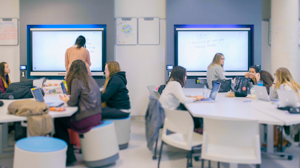
View an accessible transcript of the above video
For early childhood educational professionals, new innovations and evolutions in the classroom are a constant. Now, students in the Early Childhood Studies and other programs at the University of Guelph-Humber can experience the newest teaching methods first-hand in UofGH’s inventive Learning Lab.
After opening last fall, the technologically enhanced learning space became an experiential showcase for the innovative and flexible teaching methods that are helping educators connect with students and adjust to their preferred learning styles.
“It was really created with this idea of inclusivity in mind,” said Early Childhood Studies Program Head Dr. Nikki Martyn. “At Guelph-Humber, we’re all about learning and living through experiences. So the idea of this classroom really came from wanting our students to live and experience these methods so that when they’re working with, educating and supporting children, they really understand the experience.”
The Learning Lab features interactive Smart Boards that allow students to wirelessly share ideas, multimedia content or data, or collaborate creatively using their own handheld devices. Or, students are free to grab a portable whiteboard and move around the room, scribbling ideas on the go.
In his Children and Technology class in the spring, instructor Anthony Randell brought his two pre-teen sons and some of their friends to class and, utilizing the Learning Lab’s tools, the children provided first-person tutorials for students learning how to play the popular sandbox game Minecraft.
“It’s important that educators and people working with children know how to use technology,” Dr. Martyn said. “The only way we can do that is to make technology a tool within the classroom. It becomes a vehicle for them to be able to collaborate.”
Movement is another big feature of the Learning Lab. The classroom features standing desks, wiggle seats, bicycle desks and wheel chairs, not to mention fidget toys, Lego and Play-Doh.
“The different kind of seating was really thoughtfully designed with the idea of inclusion. Everything’s movable. They can sit on the floor. They can lie down. What would that feel like? And for students, truly, what does it feel like to be really seen as who you are? Because isn’t that what we want for kids?” Dr. Martyn said.
“It’s remarkable watching these students. They’re moving, they’re playing with things, they’re rolling, they’re collaborating,” she added. “This is a space that’s more reflective of who students are at this point in their life, rather than a structured seating environment. Students are adaptable. They are constantly on their technology. This is the world they’re engaging in and we need to meet them where they are so they can be prepared to educate or support the next generation of kids in this world.”


